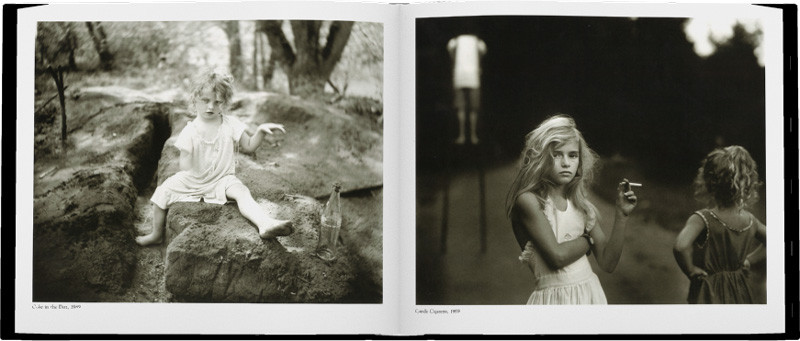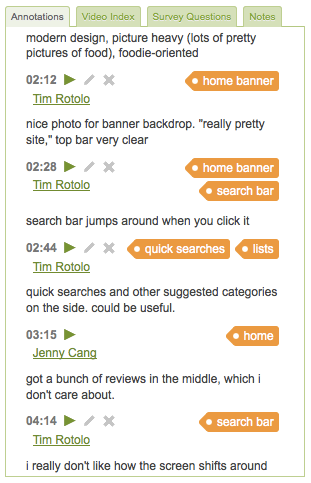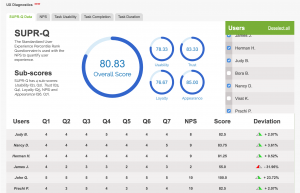“You X …” is a recurring series on creative ideas and interesting stories to inspire great UX design. You X Art volume II is the fourth installment in this series.
 “Before the invention of photography,” Sally Mann writes in her 2015 memoir Hold Still, “significant moments in the flow of our lives would be like rocks placed in a stream: impediments that demonstrated but didn’t diminish the volume of the flow and around which accrued the debris of memory, rich in sight, smell, taste, and sound.”
“Before the invention of photography,” Sally Mann writes in her 2015 memoir Hold Still, “significant moments in the flow of our lives would be like rocks placed in a stream: impediments that demonstrated but didn’t diminish the volume of the flow and around which accrued the debris of memory, rich in sight, smell, taste, and sound.”
Usability testing, like photography, is to glimpse and catalogue the brief, fleeting experience of a subject. Both are, ultimately, a concession. No amount of artistry will ever make a photograph as tangibly rich as the experience itself or its memory. Likewise, even the most sophisticated designer will fail to render the full experience of a user from usability testing alone.
But, with a wink and a smile, photographers and UX designers try anyway.

Intimacy in portraits; empathy in design
Sally Mann is best known for a series of photographs of her young children taken between 1984-1991, released in a collection entitled Immediate Family (c. 1992). Controversial for their time, Mann photographed her children both at-play and in staged sessions, with a dozen or so of the 65 photos featuring the children nude.
By turns lauded as high art and demonized as child pornography, Immediate Family introduced a wider world to the relatively obscure Southern photographer. Mann’s expressive printing style, antiquated development process, and gothic subject matter would go on to influence a generation of artists.
What can UXers learn from Mann’s unyielding work?
Intimate juxtaposition
Immediate Family is a series of photographs that gets as close as possible to the transience of youth. The adult viewer will look upon Mann’s work and feel the twinge of memories from what now feels like the briefest forever ago. Youth, like time frozen in photography, is over before it is realized.

Even in her most innocent photographs, portraits of her children at play, darkness creeps into the frame, simultaneously placing a high, almost angelic contrast on the subject while hinting at the impending loss of innocence to their budding adolescence and the world at-large.
Mann references the Japanese concept of mono no aware, or beauty tinged with sadness, in her memoir to explain that “there cannot be any real beauty without the indolic whiff of decay.” This way of seeing the world in contrast is necessary for understand her wider work.

Mann writes loosely of the humiliated, scornful defeat of Southern ideals that permeates well-into the 1980s via lies and omission. To Mann, even the landscape exhales these memories in the humid haze of Southern summers, in an almost Proustian manner of involuntary memory. Though for Mann and the South, these memories are warped and distorted.
The Mann children become still lives of an abstract progeria: representing infinite childlike innocence juxtaposed with the constant memory of death, humiliation, and ignorance that only adults can struggle to articulate.
Empathetic UX design
Just as Mann’s “intimate photographs of her children reveal truths that embody the individuality of her own family yet ultimately take on a universal quality,” a successful usability test uncovers the universal experience of all users through the the experiences of a only a handful of testers.
To achieve this, UX designers must design with a high degree of empathy. Building an understanding of how your user will feel when interacting with your product leads to a more informed design process.
While Mann displays intimacy, you must practice empathy. Where should you begin?
1. Dismiss your assumptions
The first step is to remember that you are not your user. Sally Man distances herself from her own children through a camera. So too must UX designers never forget that what they take for granted is not necessarily what the user will take for granted.
Consider that UX is experienced by real people, not taught to them via experts in the field. Casting aside preconceived notions will enable you to experience your product through the user’s eyes.
2. Ask open-ended questions to engage in an actual dialogue
Ask your testers to explain their feelings and motivations, both during the usability test and in the post-test surveys. This may reveal insights into their mental models, expectations, fears, peeves, and other information that can only be gleaned by engaging in a dialogue instead of a strictly ask and answer relationship.
3. Use the best qualitative tools at your disposal
 The UX Crowd, a TryMyUI exclusive, is a crowd-sourced opinion tool that allows users to submit suggestions and then rank the suggestions of others. This creates an idea cloud of positive, negative, and neutral feedback, giving your team greater insights into the thoughts of users.
The UX Crowd, a TryMyUI exclusive, is a crowd-sourced opinion tool that allows users to submit suggestions and then rank the suggestions of others. This creates an idea cloud of positive, negative, and neutral feedback, giving your team greater insights into the thoughts of users.

While the UX Crowd is a great tool to get to some crowd-sourced and validated feedback, all UXers know that the recordings themselves are still the most important part of testing. But having each team member watch every 15-minute video independently can lead to a lot of time lost and resources expended.
The TryMyUI solution is video annotation and multi-seat collaboration. Imagine a team of three UX designers with their own logins dividing and conquering a mountain of tester videos. That’s already great, but we can do even more!
With video annotation, the designers can make crucial, time-stamped notes in videos so that team members can quickly jump around to the most relevant portions of video.
This ability can then culminate in generated highlight reels, designed to give stakeholders a taste of usability testing via showing them the hard, qualitative facts. Highlight reel generation is practically a presentation’s worth of evidence to validate your design decisions!
4. Build a team that is willing to put in the time to build empathy
A team with a unified sense of purpose is perhaps the most important contributor to successful usability testing and UX design.
Sit down with your entire team and review user testing videos together. Build empathy maps of your users and discuss how they relate and differ from each other and from yourselves. Develop plans to hold regular meetings to review, acknowledge, and explore how empathy can be built and practiced.
You may find, like with open-ended questions in your usability studies, that these sorts of meetings have the hidden benefit of building a deeper connection and understanding within your own team.

Experimentation and iteration in photography and usability
Much of Mann’s most celebrated work dates to the 80s and early 90s, but she never stopped innovating her techniques or finding new subject matter. From family, landscapes, selfies, and corpses, Mann always found something to take a photo of. But just as importantly, Mann never shied away from diverse developing techniques, include scratching, blurring, or burning the raw film.
Although UX designers should never view their usability tests as an experiment, nor their testers as test subjects in the laboratorial sense, UXers and photographers due share in a never-ending struggle towards perfection via experimentation and iteration.
Experimentation in photography

Mann’s sense of experimentation was the result of fortunate opportunity and carnal necessity. Mann managed to come across antique materials and tools in the South that she would use to develop her unique style. She became accustomed to working in darkrooms during college, just to “be alone with her boyfriend.”
Into the 1990s, Mann further experimented with her technique. She began creating lens flares and other abnormalities by fitting her camera with an enormous, faulty antique lens (pictured left).
She also adopted a nineteenth-century method of developing film called “collodion wet-plate process.” This was a laborious technique, involving coating a glass plate with collodion, a syrupy substance, dipping the coated plate into a solution of silver salts to make it light sensitive, and then loading the plate into the camera for exposure, before finally developing it.

This must all be done in minutes, before the collodion dries.
The results are expressive imperfections, or as she called the high-contrast images she captured, the “radical light of the American South.” This harkens back to the imperfect, imperceptible memories that soak up the dark Southern heat from her Immediate Family and earlier works.
Experimentation in usability testing

Although the techniques of usability testing aren’t quite as obviously far-reaching as photography, UX designers can still experiment in meaningful ways, such as psychometric modeling.
There are various psychometric models and questionnaires available (on our platform anyway) to choose from.
For example, a psychometric like the SUPR-Q measures more than just usability. The SUPR-Q (Standardized User Experience Percentile Rank Questionnaire) measures loyalty, trust, and appearance as well. This is generally best used for well-established design flows that are already quite usable, having been tested previously with more standard models like the SUS.
Additionally, you may find that tweaking your demographics to users who don’t necessarily fit your model may be a smart decision. When we ran our usability study on US political candidate websites, we found that testers based in the US displayed heavy bias. So we tried Canadian testers instead, and voila, our findings were hugely insightful!
Don’t be afraid to tweak your tests! From scripts, models, demographics, and screeners, the potential is limitless!
Iteration in photography

Photographers, obviously, will take various photos of the same scene, with mild adjustments to lighting, staging, angles, lenses, and so on. But Sally Mann’s iterative process takes it to a new level of dedication.
One of the most striking photographs from Immediate Family features Mann’s son Emmett (left) standing nude in a river. It is important to note that no nudity is actually on display.
According to Mann, the river was bone-chillingly cold. Despite the discomfort, Emmett remained patient while Mann searched for the perfect photograph. This wasn’t just a few minutes or even a few hours. Mann and Emmett returned to the river over several days, posing and shivering.
Although her children did practice a level of respect and understanding for Mann and her work, Emmett refused to model nude for his mother ever again after she was satisfied with the image. The 1987 photograph is aptly titled The Last Time Emmett Modeled Nude.
Iterative usability testing
 Whereas Sally Mann, and any photographer, is obsessed with the perfect photo, UX designers are striving for the perfect user experience. Repetition and tweaking for photographers equates to iterative testing for UXers, commonly referred to simply as “UX sprints.”
Whereas Sally Mann, and any photographer, is obsessed with the perfect photo, UX designers are striving for the perfect user experience. Repetition and tweaking for photographers equates to iterative testing for UXers, commonly referred to simply as “UX sprints.”
Sprint testing should not have to be preached or proselytized to contemporary UX designers. But if you aren’t convinced, Sprints are proven to show the impact of every design decision you make, working towards a near-perfect design.
You can run new sprints of your usability tests, passing the same set of tasks to a new batch of testers to perform, and then view direct metric comparisons between new and old tester results to see how the usability of your designs has changed.
On TryMyUI, we’ve added the UX Sprint feature directly into the UX Diagnostics panel for quick and easy comparisons.

Photography and usability: forever economized endeavors
Mann, ever the erudite, is blunt in her memoir when reminding readers that photography is not reality:
“All perception is selection, and all photographs–no matter how objectively journalistic the photographer’s intent–exclude aspects of the moment’s complexity. Photographs economize the truth; they are always moments more or less illusorily abducted from time’s continuum.”
Usability tests, too, are only an economized experience of the user. It’s up to the UX designer to not be discouraged, but instead embrace this reality with great empathy, patience, and want to design, and design well.
You may be interested in:
You X History: Oda Nobunaga and the disruptive startup you need to know





